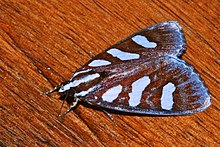Mimeusemia
| Mimeusemia | |
|---|---|

| |
| Scientific classification | |
| Kingdom: | Animalia |
| Phylum: | Arthropoda |
| Class: | Insecta |
| Order: | Lepidoptera |
| Superfamily: | Noctuoidea |
| Family: | Noctuidae |
| Subfamily: | Agaristinae |
| Genus: | Mimeusemia Butler, 1875 |
Mimeusemia is a genus of moths of the family Noctuidae first described by Arthur Gardiner Butler in 1875. Species are found in Japan, India, Sri Lanka and Myanmar.
Description[]
Veins 9 and 10 of the forewing both anastomosing (fusing) with veins 7 and 8 to form an areole. Claspers of male are large.[1]
Species[]
- Swinhoe, 1889
- Hampson, 1894
- Kishida, 1993
- Walker, 1854
- Rothschild, 1896
- Mimeusemia ceylonica Hampson, 1893
- Swinhoe, 1899
- Hampson, 1900
- Jordan, 1939
- Rothschild, 1897
- Rothschild, 1896
- Butler, 1875
- Moore, 1858
- Walker, 1862
- Druce, 1895
- Herrich-Schäffer, [1853]
- Lucas, 1891
- Hampson, 1911
- Butler, 1875
References[]
- ^ Hampson, G. F. (1894). The Fauna of British India, Including Ceylon and Burma: Moths Volume II. Taylor and Francis – via Biodiversity Heritage Library.
- Kishida, Y. (1993). "The agaristine moths of south east Asia (3), Description of three new forms of Longicella, Cruriopsis and Mimeusemia (Noctuidae: Agaristinae)." Gekkan-Mushi (269): 12–13.
- Savela, Markku. "Mimeusemia Butler, 1875". Lepidoptera and Some Other Life Forms. Retrieved January 20, 2019.
- Pitkin, Brian & Jenkins, Paul. "Search results Family: Noctuidae". Butterflies and Moths of the World. Natural History Museum, London.
Categories:
- Agaristinae
- Agaristinae stubs